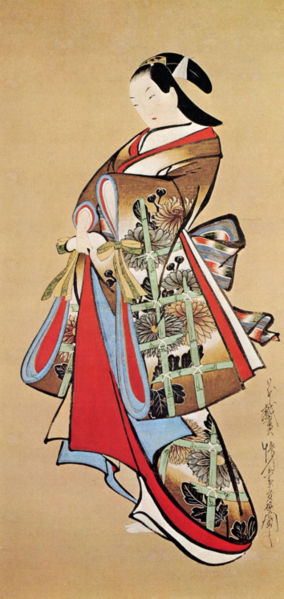Difference between revisions of "Kaigetsudo school"
(create page) |
|||
| (5 intermediate revisions by the same user not shown) | |||
| Line 1: | Line 1: | ||
[[Image:Kaigetsudo Dohan - bijin2.jpg|right|thumb|300px|A ''bijinga'' by [[Kaigetsudo Dohan|Kaigetsudô Dohan]]. Color on silk.]] | [[Image:Kaigetsudo Dohan - bijin2.jpg|right|thumb|300px|A ''bijinga'' by [[Kaigetsudo Dohan|Kaigetsudô Dohan]]. Color on silk.]] | ||
| − | *''Japanese'': | + | *''Founded: c. [[1700]]-[[1714]], [[Kaigetsudo Ando|Kaigetsudô Ando]]'' |
| + | *''Japanese'': [[壊月堂]]派 ''(Kaigetsudou-ha)'' | ||
| Line 25: | Line 26: | ||
*[[Takizawa Shigenobu]] | *[[Takizawa Shigenobu]] | ||
*[[Baiyuken Katsunobu|Baiyûken Katsunobu]] | *[[Baiyuken Katsunobu|Baiyûken Katsunobu]] | ||
| − | *[[Baioken | + | *[[Baioken Eishun|Baiôken Nagaharu]] |
*[[Takeda Harunobu (artist)|Takeda Harunobu]] | *[[Takeda Harunobu (artist)|Takeda Harunobu]] | ||
| Line 34: | Line 35: | ||
[[Category:Artists and Artisans]] | [[Category:Artists and Artisans]] | ||
| + | [[Category:Art and Architecture]] | ||
| + | [[Category:Edo Period]] | ||
Latest revision as of 23:34, 21 January 2013

- Founded: c. 1700-1714, Kaigetsudô Ando
- Japanese: 壊月堂派 (Kaigetsudou-ha)
The Kaigetsudô school was a school of ukiyo-e painting and printmaking founded in Edo around 1700-1714. It is often said that the various Kaigetsudô artists' styles are so similar, many scholars find it nearly impossible to differentiate them; thus, many Kaigetsudô paintings attributed to the school's founder, Kaigetsudô Ando, which may have been in fact painted by his disciples.
The school's founder, Ando Yasunori, known by his art-name (gô) Kaigetsudô Ando, was a specialist in bijinga, images of beautiful women. Unlike his disciples, Ando produced only paintings, never prints. His style, and that of the school, draws strongly upon the style of the Torii school, which is known primarily for its theater signboards. The style of both schools is distinguished by its use of thick lines and bright colors. However, the Kaigetsudô style is said to depict subjects in a very stereotyped manner, which is in sharp contrast to the style of the Torii school.
The Kaigetsudô artists are known primarily for their prints of bijin with very colorful and complex patterns on their kimono. While these images may be seen as displaying fashion designs, it is far more likely that the artists' intended to focus on the beauty and grace of the women themselves. The printmakers sought to share the fame and magnificence of the women of the Yoshiwara with those unable to afford to experience the ukiyo (Floating World) in person.
While the school of course produced many unique works, many were based on reproducing very similar poses or images, with only the colors or kimono pattern changed.
Though a handful of artists took on the Kaigetsudô name for themselves, and sought to imitate the style, the work of Kaigetsudô Ando's direct disciples fell into sharp decline after his banishment to Ôshima in 1714.
Significant Artists of the Kaigetsudō school
- Kaigetsudô Ando - founder of the school
- Kaigetsudô Anchi
- Kaigetsudô Dohan
- Kaigetsudô Doshin
- Kaigetsudô Doshu
- Kaigetsudô Doshû
- Matsuno Chikanobu
- Tôsendô Rifû
- Takizawa Shigenobu
- Baiyûken Katsunobu
- Baiôken Nagaharu
- Takeda Harunobu
References
- This article was written by User:LordAmeth and contributed to both S-A and Wikipedia; the author gives permission for his work to be used in this way.
- Frederic, Louis (2002). "Japan Encyclopedia." Cambridge, Massachusetts: Harvard University Press.
- Paine, Robert Treat and Alexander Soper (1955). "The Art and Architecture of Japan." New Haven: Yale University Press.